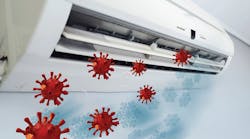4 Ways to Combat Pathogens in Your HVAC System —
Jake owns and runs a small commercial shop. He has been coughing a lot, and is growing concerned as his employees have been calling in sick with sinus problems and bronchitis. He calls his friend Rick, who operates a different business but in the same block. To Jake’s surprise, Rick and his workers have not missed any time from work.
While Rick’s employees have been healthy, Jake’s problems are just beginning! A customer notices "black stuff" around an HVAC register, so Jake calls an HVAC duct cleaner, who discovers black mold (stachybotrys — the worst kind of mold).
The HVAC firm is required to inform the city’s health department, who quarantine Jake’s building until mold abatement is complete. This process takes 2 weeks and costs Jake $15,000 plus the lost business! When Jake reopens, customers remain leery of returning to the shop even though the mold problem no longer exists. Jake’s business ultimately closes permanently — as do 90% of businesses caught in such a situation.
InvisiLight® Solution for Deploying Fiber
April 2, 2022Go to Market Faster. Speed up Network Deployment
April 2, 2022Episode 10: Fiber Optic Closure Specs Explained…
April 1, 2022Food for Thought from Our 2022 ICT Visionaries
April 1, 2022Rick tells a depressed Jake that he should have had a whole building SMART ventilation system like the one he has at his business – or at the very least an HVAC UV coil sanitizer, like another local shop owner, Joe.
How do such systems and devices work, and how might they have kept Jake from going out of business? And why is controlling the growth of mold and bacteria an important issue for any businessperson?
SANITIZING YOUR SYSTEM
Fortunately, there are proven ways to sanitize your HVAC system, but if the wrong type of device is chosen, or the wrong size is installed, the science shows they just don’t work.
Here are the benefits and limitations of each/
1. HVAC UV COIL SANITIZERS
Benefits
* Uses UV light, to kill viruses, bacteria and mold on the HVAC condenser coil and drip pan
* Eliminates viruses, mold and bacteria in ducts by removing the source on the coil
* Must meet three criteria to be effective:
1) MUST be Type C UV light (aka UVC light)
2) MUST provide 30 watts of UVC light power at 12 inches from the light source (40-watt bulb or equivalent) located no further than 18 inches from the furthest part of the coil
3) MUST SHINE light on all sides of the coil (at least 2 bulbs, top and bottom)
Limitations
Most DIY and even professionally installed UV sanitizers fail to meet all three criteria. For instance, most only have one 20-watt bulb, which is too little to be effective as a sanitizer.
2. OZONE GENERATORS
Benefits
* Introduce charged ozone molecules into the air INSIDE the device, which in turn creates a charge on airborne particles such as dust, pollen, viruses, mold, bacterial spores, and smoke particles. These charged particles become trapped in a removable filter or degrade due to the damage caused by the ozone.
* Most professionally installed units are properly sized for the HVAC unit and do a great job.
Limitations
* Most DIY ozone generators do not provide enough ozone to sanitize the coil and ducts. In addition, ozone leaves the device mixed with the "cleaned" air. This ozone contributes to poor indoor air quality – essentially trading one problem for another one.
3. WHOLE BUILDING SMART VENTILATION SYSTEMS
Benefits
* Monitor outdoor and indoor air quality and exchanging the indoor air for outdoor air when the outdoor air quality in better than the indoor air quality.
* Expel airborne particles (dust, pollen, viruses, mold, bacterial spores, and smoke) with the exhausted stale indoor air.
* Expel gasses like volatile organic compounds (VOCs), pollutant gases, odors, CO2, carbon monoxide, formaldehyde, sulfurous gasses, nitrogenous gasses, radon, etc. with the exhausted stale indoor air.
* Optimize the indoor air quality based on the best available air quality, adding outdoor humidity as needed or expelling air when the indoor humidity is subpar.
* Utilize outdoor air instead of running the compressor, when outdoor temperatures are appropriate to cool or heat the indoor space, thus extending coil drying time and eliminating the water required for mold and bacteria growth.
4. PROBIOTIC AIR CLEANERS
Benefits
* Portable devices ideal for use in a single room.
* Like any ultrasonic mister, these devices can produce a mist cloud large enough to fill a standard-size private office.
* Supposedly spray "beneficial" bacteria into the air.
Limitations
* Claim that the probiotic bacteria cancel out bad bacteria on surfaces, thus reducing illnesses. But for this to work, bacteria would need to grow to significant (slimy) levels on surfaces. While this may occur on wet surfaces, most surfaces in businesses are dry, and the bacteria would die in minutes or hours without significant growth.
* They have no effect on pollen, viruses, mold, dust, smoke or VOCs.
* They add humidity to the building and water to the HVAC system.
* While probiotics may have health benefits, there is no scientific evidence that probiotics will help your HVAC health.
Like this Article?
Subscribe to ISE magazine and start receiving your FREE monthly copy today!
SUMMARY
When it comes to combatting mold and bacteria in your HVAC system, professionally installed systems sized correctly and maintained annually, can and will remove the problem before costly damage is done to furnishings, building, or your health. Had Jake done so, maybe his printing shop would still be in business.









